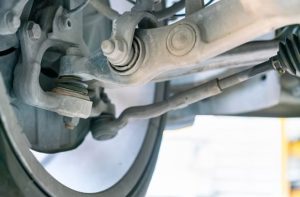Ball joints are small but crucial components of a vehicle’s suspension and steering system. They connect the control arms to the steering knuckle, allowing the wheel to move freely both vertically (suspension travel) and horizontally (steering direction). While upper and lower ball joints may appear similar, their functions, loads, and failure patterns differ significantly. Understanding these differences is essential for proper maintenance and safe driving.
What Ball Joints Do in a Suspension System

In a typical front suspension, ball joints act as pivot points that allow:
-
Steering movement
-
Suspension articulation
-
Maintaining wheel alignment angles
Depending on the suspension type—double wishbone or MacPherson strut — a vehicle may use both upper and lower ball joints or only a lower joint with a strut replacing the upper assembly. When both are present, they perform distinct roles.
Upper vs. Lower Ball Joints: Core Differences
Although designed similarly, these two parts are not interchangeable. Their mechanical responsibilities, load characteristics, and design vary based on position within the suspension system.
Load Responsibilities
| Ball Joint | Primary Function | Load Level |
|---|---|---|
| Upper Ball Joint | Guides movement and maintains alignment | Low to moderate |
| Lower Ball Joint | Supports vehicle weight; handles road impacts | High |
The lower ball joint is almost always the load-bearing component, supporting the weight of the vehicle and absorbing road shocks. The upper ball joint typically plays a guiding role.
Structural Strength and Design
Lower ball joints are generally:
-
Larger
-
Stronger
-
Built with heavy-duty components
Upper ball joints are:
-
Lighter
-
More compact
-
Designed for motion control rather than load support
Because of these distinctions, lower ball joints wear out more quickly.
Influence on Steering and Alignment
Upper Ball Joint Role
-
Helps stabilize camber angle
-
Reduces lateral movement
-
Maintains the upper pivot point of the knuckle
Lower Ball Joint Role
-
Influences caster angle and steering feel
-
Stabilizes the wheel during braking
-
Bears the majority of suspension load
Together, they ensure precise steering, predictable handling, and consistent tire wear.
Wear Characteristics and Lifespan
| Characteristic | Upper Ball Joint | Lower Ball Joint |
|---|---|---|
| Wear Rate | Slower | Faster |
| Typical Lifespan | Longer | Shorter |
| Common Issues | Boot cracking, looseness | Excessive play, collapse |
| Failure Severity | Moderate | High (risk of wheel fold-under) |
Lower ball joint failure is particularly dangerous because the wheel can collapse inward, making the vehicle uncontrollable.
Symptoms of Upper vs. Lower Ball Joint Wear
Upper Ball Joint Symptoms
-
Mild steering looseness
-
Slight uneven tire wear
-
Vehicle drifting to one side
Lower Ball Joint Symptoms
-
Loud clunking noises
-
Front-end vibrations
-
Wheel wobble or wandering
-
Rapid tire wear on edges
-
Visible sagging or tilting wheel
Any severe symptoms almost always point to the lower ball joint.
Replacement Recommendations
Mechanics often advise replacing both upper and lower ball joints when:
-
The vehicle has high mileage
-
The same control arm houses both joints
-
One joint fails, indicating similar use conditions
Replacing in pairs ensures consistent suspension performance and easier wheel alignment.
How to Choose the Right Ball Joints

When shopping for ball joints, pay attention to:
-
Material quality of the ball stud
-
Durability of the rubber boot
-
Whether the joint is sealed or greaseable
-
Compatibility with your vehicle’s suspension design
-
Brand reputation and certification
For heavy-duty or performance driving, reinforced ball joints offer superior longevity.
Where to Purchase Upper and Lower Ball Joints
For reliable, high-quality parts for any vehicle, you can Buy Ball Joints online here:
Buy Ball Joints online
The catalog includes upper, lower, load-bearing, and guide-type ball joints from trusted manufacturers.
Conclusion
Upper and lower ball joints may share a similar design, but their roles within the suspension system are fundamentally different. The upper ball joint primarily stabilizes steering geometry, while the lower ball joint carries the vehicle’s weight and absorbs road impacts. Because of these different responsibilities, the lower ball joint typically wears out faster and requires more frequent inspection. Understanding these distinctions helps drivers diagnose early symptoms, choose the correct replacement parts, and maintain safe, predictable handling.
A well-functioning pair of ball joints ensures proper wheel alignment, smooth steering, and overall road safety — making timely maintenance essential for every vehicle owner.